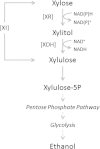Process intensification through microbial strain evolution: mixed glucose-xylose fermentation in wheat straw hydrolyzates by three generations of recombinant Saccharomyces cerevisiae
- PMID: 24708666
- PMCID: PMC4234986
- DOI: 10.1186/1754-6834-7-49
Process intensification through microbial strain evolution: mixed glucose-xylose fermentation in wheat straw hydrolyzates by three generations of recombinant Saccharomyces cerevisiae
Abstract
Background: Lignocellulose hydrolyzates present difficult substrates for ethanol production by the most commonly applied microorganism in the fermentation industries, Saccharomyces cerevisiae. High resistance towards inhibitors released during pretreatment and hydrolysis of the feedstock as well as efficient utilization of hexose and pentose sugars constitute major challenges in the development of S. cerevisiae strains for biomass-to-ethanol processes. Metabolic engineering and laboratory evolution are applied, alone and in combination, to adduce desired strain properties. However, physiological requirements for robust performance of S. cerevisiae in the conversion of lignocellulose hydrolyzates are not well understood. The herein presented S. cerevisiae strains IBB10A02 and IBB10B05 are descendants of strain BP10001, which was previously derived from the widely used strain CEN.PK 113-5D through introduction of a largely redox-neutral oxidoreductive xylose assimilation pathway. The IBB strains were obtained by a two-step laboratory evolution that selected for fast xylose fermentation in combination with anaerobic growth before (IBB10A02) and after adaption in repeated xylose fermentations (IBB10B05). Enzymatic hydrolyzates were prepared from up to 15% dry mass pretreated (steam explosion) wheat straw and contained glucose and xylose in a mass ratio of approximately 2.
Results: With all strains, yield coefficients based on total sugar consumed were high for ethanol (0.39 to 0.40 g/g) and notably low for fermentation by-products (glycerol: ≤0.10 g/g; xylitol: ≤0.08 g/g; acetate: 0.04 g/g). In contrast to the specific glucose utilization rate that was similar for all strains (qGlucose ≈ 2.9 g/gcell dry weight (CDW)/h), the xylose consumption rate was enhanced by a factor of 11.5 (IBB10A02; qXylose = 0.23 g/gCDW/h) and 17.5 (IBB10B05; qXylose = 0.35 g/gCDW/h) as compared to the qXylose of the non-evolved strain BP10001. In xylose-supplemented (50 g/L) hydrolyzates prepared from 5% dry mass, strain IBB10B05 displayed a qXylose of 0.71 g/gCDW/h and depleted xylose in 2 days with an ethanol yield of 0.30 g/g. Under the conditions used, IBB10B05 was also capable of slow anaerobic growth.
Conclusions: Laboratory evolution of strain BP10001 resulted in effectively enhanced qXylose at almost complete retention of the fermentation capabilities previously acquired by metabolic engineering. Strain IBB10B05 is a sturdy candidate for intensification of lignocellulose-to-bioethanol processes.
Figures



Similar articles
-
Fermentation of mixed glucose-xylose substrates by engineered strains of Saccharomyces cerevisiae: role of the coenzyme specificity of xylose reductase, and effect of glucose on xylose utilization.Microb Cell Fact. 2010 Mar 10;9:16. doi: 10.1186/1475-2859-9-16. Microb Cell Fact. 2010. PMID: 20219100 Free PMC article.
-
Stepwise metabolic adaption from pure metabolization to balanced anaerobic growth on xylose explored for recombinant Saccharomyces cerevisiae.Microb Cell Fact. 2014 Mar 8;13(1):37. doi: 10.1186/1475-2859-13-37. Microb Cell Fact. 2014. PMID: 24606998 Free PMC article.
-
Saccharomyces cerevisiae strain comparison in glucose-xylose fermentations on defined substrates and in high-gravity SSCF: convergence in strain performance despite differences in genetic and evolutionary engineering history.Biotechnol Biofuels. 2017 Sep 4;10:205. doi: 10.1186/s13068-017-0887-9. eCollection 2017. Biotechnol Biofuels. 2017. PMID: 28878820 Free PMC article.
-
[Progress in the pathway engineering of ethanol fermentation from xylose utilising recombinant Saccharomyces cerevisiae].Sheng Wu Gong Cheng Xue Bao. 2003 Sep;19(5):636-40. Sheng Wu Gong Cheng Xue Bao. 2003. PMID: 15969099 Review. Chinese.
-
Bioconversion of lignocellulose-derived sugars to ethanol by engineered Saccharomyces cerevisiae.Crit Rev Biotechnol. 2012 Mar;32(1):22-48. doi: 10.3109/07388551.2010.539551. Epub 2011 Jan 4. Crit Rev Biotechnol. 2012. PMID: 21204601 Review.
Cited by
-
Biobutanol production from C5/C6 carbohydrates integrated with pervaporation: experimental results and conceptual plant design.J Ind Microbiol Biotechnol. 2016 Jan;43(1):25-36. doi: 10.1007/s10295-015-1717-3. Epub 2015 Dec 14. J Ind Microbiol Biotechnol. 2016. PMID: 26667831
-
A novel chimaeric flocculation protein enhances flocculation in Saccharomyces cerevisiae.Metab Eng Commun. 2018 Apr 9;6:49-55. doi: 10.1016/j.meteno.2018.04.001. eCollection 2018 Jun. Metab Eng Commun. 2018. PMID: 29896447 Free PMC article.
-
Cellulose surface degradation by a lytic polysaccharide monooxygenase and its effect on cellulase hydrolytic efficiency.J Biol Chem. 2014 Dec 26;289(52):35929-38. doi: 10.1074/jbc.M114.602227. Epub 2014 Oct 31. J Biol Chem. 2014. PMID: 25361767 Free PMC article.
-
The emergence of adaptive laboratory evolution as an efficient tool for biological discovery and industrial biotechnology.Metab Eng. 2019 Dec;56:1-16. doi: 10.1016/j.ymben.2019.08.004. Epub 2019 Aug 8. Metab Eng. 2019. PMID: 31401242 Free PMC article. Review.
-
Improving Acetic Acid and Furfural Resistance of Xylose-Fermenting Saccharomyces cerevisiae Strains by Regulating Novel Transcription Factors Revealed via Comparative Transcriptomic Analysis.Appl Environ Microbiol. 2021 Apr 27;87(10):e00158-21. doi: 10.1128/AEM.00158-21. Print 2021 Apr 27. Appl Environ Microbiol. 2021. PMID: 33712428 Free PMC article.
References
-
- Palmqvist E, Hahn-Hägerdal B. Fermentation of lignocellulosic hydrolysates, II: inhibitors and mechanisms of inhibition. Bioresour Technol. 2000;1:25–33.
-
- van Maris A, Abbott D, Bellissimi E, van den Brink J, Kuyper M, Luttik M, Wisselink H, Scheffers W, van Dijken J, Pronk J. Alcoholic fermentation of carbon sources in biomass hydrolyzates by Saccharomyces cerevisiae: current status. Antonie Van Leeuwenhoek. 2006;90:391–418. doi: 10.1007/s10482-006-9085-7. - DOI - PubMed
LinkOut - more resources
Full Text Sources
Other Literature Sources
Molecular Biology Databases

